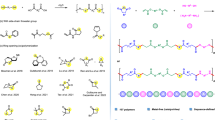Abstract
THE steric requirements of molecules dominate the rates and equilibria of many reactions in organic and inorganic chemistry. It is still difficult to make precise calculations of steric effects, but in many cases the qualitative principles controlling steric requirements have become apparent. For example, in reactions that involve addition to an unsaturated function containing a double bond, the empirical ‘rule of six’ correctly states “the greater the number of atoms in the six position, the greater will be the steric effect”1. The rule of six has also been used to interpret conformations of polypeptides and proteins and to explain hydrolysis rates of di- and poly-peptides2.
This is a preview of subscription content, access via your institution
Access options
Subscribe to this journal
Receive 51 print issues and online access
$199.00 per year
only $3.90 per issue
Buy this article
- Purchase on SpringerLink
- Instant access to full article PDF
Prices may be subject to local taxes which are calculated during checkout
Similar content being viewed by others
References
Newman, M. S., in Steric Effects in Organic Chemistry, edit. by Newman, M. S., 206 (John Wiley and Sons, Inc., New York, 1956).
Whitfield, R. E., Science, 142, 577 (1963).
Halpern, B., and Westley, J. W., Chem. Commun., 246 (1965).
Author information
Authors and Affiliations
Rights and permissions
About this article
Cite this article
HALPERN, B., WESTLEY, J. & WEINSTEIN, B. Investigation of Steric Effects about the Amide Bond by Gas–Liquid Chromatography. Nature 210, 837 (1966). https://doi.org/10.1038/210837a0
Issue date:
DOI: https://doi.org/10.1038/210837a0



